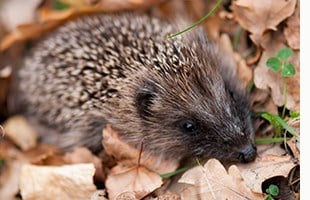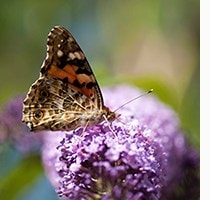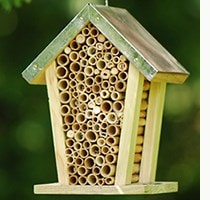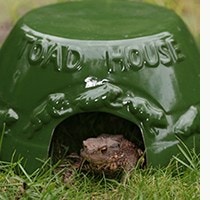How to create a wildlife-friendly garden

Wildlife-friendly gardens are not only more interesting as you can watch all the comings and goings, but they are often more productive as many creatures will help increase pollination. Garden ponds act as a magnet to dragonflies and damsel flies, along with slug-eating frogs and toads. Any plot which teams with wild creatures, such as birds, insects, bats and even hedgehogs, will have its own system of pest control. There will be a natural balance between the predators and their prey creating a sustainable ecosystem. An average garden contains many hundreds if not thousands of species of insect, a handful of which are plant pests. If the garden also contains a range of voracious insect-eating predators including birds, small mammals, amphibians, spiders and other creatures they will keep insect populations under control and prevent the pests from becoming a serious problem. It makes sense, therefore, to attract pest predators into your garden and then encourage them to stay by offering them a suitable environment for them to thrive.
Birds to encourage
The following birds will eat pests in their diet.
Insect eaters: blue tits, blackbirds, robins, starlings, great tits, magpies, song thrush and wren.
Slug and snail eaters: song thrush, fieldfares and black birds.
Beneficial insects to encourage
The following are all renowned insect pest eaters: ladybirds, hoverflies, wasps (particularly parasitic species), ground beetles and lacewings.
 Slug and snail eaters: ground beetles and centipedes.
Slug and snail eaters: ground beetles and centipedes.
Useful creatures to encourage
The following will eat pests in their diet:
Insect eaters: centipedes, spiders, hedgehogs, frogs and toads, slow worms, newts, lizards and bats.
Slug and snail eaters: hedgehogs, frogs and toads, newts, slow worms.
Beneficial garden features for wildlife include:
- Compost heaps – where slow worms can breed and hedgehogs can hibernate.
- Piles of logs – to provide a hiding place for frogs, amphibians and ground beetles.
- Thick hedges – to provide cover and suitable nesting sites for birds. Berrying plants will also provide food during the winter months.
- Garden ponds – to increase the range of habitats within the garden and to offer somewhere for birds to bathe and drink.
- Long grass and nettles – also encourage many insects, providing food for insect-eating predators and provide cover for many beneficial creatures.
- Berrying shrubs and trees – to provide food, shelter and nesting sites.
Providing food
 Providing food for wildlife is very easy and can be much more fun than simply hanging out a bag of nuts for the birds. Numerous plants have berries, catkins or seeds which are food for a wide variety of wildlife. Autumn is the best time for berries. Cotoneasters are many a bird's favourite and there is one for every garden as they range from the ground-hugging C. dammeri which only reaches 20cm up to the shrubby C. frigidus 'Cornubia' that grows to over 6m. Pyracantha also are excellent wildlife garden plants – they have berries for food, they can be trained against a wall, and are evergreen and spiny too so offer cover for nests. Trees often provide food and cover for birds and help support hundreds of insects, which in turn provide even more food for the birds. For a real spectacle, try growing a rowan tree and experience the annual feast as birds eat their fill of the bright red berries.
Providing food for wildlife is very easy and can be much more fun than simply hanging out a bag of nuts for the birds. Numerous plants have berries, catkins or seeds which are food for a wide variety of wildlife. Autumn is the best time for berries. Cotoneasters are many a bird's favourite and there is one for every garden as they range from the ground-hugging C. dammeri which only reaches 20cm up to the shrubby C. frigidus 'Cornubia' that grows to over 6m. Pyracantha also are excellent wildlife garden plants – they have berries for food, they can be trained against a wall, and are evergreen and spiny too so offer cover for nests. Trees often provide food and cover for birds and help support hundreds of insects, which in turn provide even more food for the birds. For a real spectacle, try growing a rowan tree and experience the annual feast as birds eat their fill of the bright red berries.
In the summer months when the garden is humming with insects there are lots of plants you can use to provide them with food. Coreopsis, fennel, dill, rudbeckia and asters are all excellent choices. Choose nectar-rich plants if you want to encourage predators, such as hoverflies and parasitic wasps, as well as other beneficial insects. These can be perennials, such as Asters, Achilleas, Agastaches, Eryngiums, Ajuga, Cirsium and Coreopsis, shrubs such as buddleja and viburnum or trees such as hawthorn or blossoming fruit trees.
 Bees are among the most useful insects in the garden but they do need your help.
Bumblebee colonies are only able to store a few days of energy reserves and so are vulnerable to the scarcity of flowers with nectar and to poor weather conditions which prevent them foraging. The fashion is to plant bright, showy, cultivated flowers, but more often than not these plants don't actually have any nectar. As a rule the old-fashioned cottage-style plants have been proved the best for bees (see the link below to view some of the best). Aim to combine plants to provide a succession of feeding stations throughout the year, so that there is at least one nectar-rich plant flowering at all times.
Bees are among the most useful insects in the garden but they do need your help.
Bumblebee colonies are only able to store a few days of energy reserves and so are vulnerable to the scarcity of flowers with nectar and to poor weather conditions which prevent them foraging. The fashion is to plant bright, showy, cultivated flowers, but more often than not these plants don't actually have any nectar. As a rule the old-fashioned cottage-style plants have been proved the best for bees (see the link below to view some of the best). Aim to combine plants to provide a succession of feeding stations throughout the year, so that there is at least one nectar-rich plant flowering at all times.
Providing shelter
 Shelter is essential for wildlife to offer shelter from predators, for hibernating and for nesting. Trees, shrubs and climbers all provide excellent protection. Spiky shrubs like berberis, Pyracantha, mahonia and roses offer good safe cover for nests, often having the added bonus of berries or hips to eat. Evergreen plants are useful for providing cover all year and are good for all round structure in the garden. climbers, in particular, are a favourite nesting spot because the wall on one side and a camouflage of leaves on the other provides safe protection. Don't be in a hurry to clear your garden in autumn, because this will provide shelter during the winter months. However, be selective: piles of diseased debris should be cleared up. You can also add special shelters for particular types of useful creatures. For example, bumble bees can spend a winter in a small terracotta pot filled with moss or finely shredded newspaper. Bury the filled pot upside-down in the ground and protect the hole from rain with stones, but leave a tiny gap for the bee to get in and out. Similarly, straws or hollow bamboo canes tied together in a bundle can be used by lacewings and ladybirds.
Shelter is essential for wildlife to offer shelter from predators, for hibernating and for nesting. Trees, shrubs and climbers all provide excellent protection. Spiky shrubs like berberis, Pyracantha, mahonia and roses offer good safe cover for nests, often having the added bonus of berries or hips to eat. Evergreen plants are useful for providing cover all year and are good for all round structure in the garden. climbers, in particular, are a favourite nesting spot because the wall on one side and a camouflage of leaves on the other provides safe protection. Don't be in a hurry to clear your garden in autumn, because this will provide shelter during the winter months. However, be selective: piles of diseased debris should be cleared up. You can also add special shelters for particular types of useful creatures. For example, bumble bees can spend a winter in a small terracotta pot filled with moss or finely shredded newspaper. Bury the filled pot upside-down in the ground and protect the hole from rain with stones, but leave a tiny gap for the bee to get in and out. Similarly, straws or hollow bamboo canes tied together in a bundle can be used by lacewings and ladybirds.
Bats and hedgehogs are more difficult to tempt into the garden. You can buy special box-shaped houses, although piles of leaves or a compost heap will be equally good. But take care when turning or emptying your compost heap between November and March when the hedgehogs are hibernating.
Create a ground beetle playground
You can significantly increase the number of friendly ground beetles in a particular area by surrounding it with a beetle-proof barrier. Since ground beetles cannot climb smooth vertical surfaces, surround your chosen area (such as the vegetable plot) with lawn edging strip sunk into a shallow trench so that the outside it is level with the top of the strip, but drops about 5cm vertically on the inside. Not only will beetles inside the plot be unable to escape, but you will also trap any careless beetles from the neighborhood that happen to scurry over the edge and drop in. You can increase the numbers further by trapping beetles in pitfall traps made from plastic cups sunk rim-deep into the soil in other parts of the garden and then release these within your special beetle playground. Don't forget to make sure there are plenty of hiding places and food for the beetles at all times.
Providing breeding sites
For birds there are innumerable nestboxes to suit all comers. Alternatively, you can make your own. For small birds a 10x10cm box that is about 25cm high at the back sloping to about 20cm at the front is ideal. Drill a small hole – 25-30mm for tits; slightly larger for nuthatches – in the front about 15cm from the floor of the box. Position nuthatch boxes about 4m off the ground and tit boxes about 2m high. Some small birds, particularly robins, prefer an open box with just a 10cm high lip of wood at the front of the box. Position these boxes about 2m from the ground. Make sure all nest boxes are securely fixed using corrosion-resistant screws. Other birds, such as black birds, will not nest in boxes, preferring to build their own out of twigs. In this case, make sure you provide plenty of safe nesting sites by cultivating dense-growing shrubs and Trees such as conifers and other evergreens, and leave piles of suitable nest-building material for the birds to pilfer. If you have a hedge, avoid trimming it until nesting birds have flown to avoid disturbing them.
Swallows and house martins prefer the eaves of a house or other building to build their nests. They use mud as their building material, so provide them with an ample supply at nesting time.
Making a wildlife pond
 Any water in the garden is a bonus for wildlife. It is important for frogs and newts, as well as for birds to drink and bathe in. Ponds also support a huge variety of insects like dragonflies, pond-skaters and water boatmen. Ponds can be any size but the larger they are the easier they will be to manage.
Any water in the garden is a bonus for wildlife. It is important for frogs and newts, as well as for birds to drink and bathe in. Ponds also support a huge variety of insects like dragonflies, pond-skaters and water boatmen. Ponds can be any size but the larger they are the easier they will be to manage.
You can also convert an existing pond to be more wildlife friendly. It is important to have plants along one side of the pond to provide cover for visiting wildlife, and to create a gently sloping beach of pebbles so that creatures can get in and out safely. A log angled into the water will also provide a safe vantage point for drinking birds and a gang-plank for other creatures. Do not include fish. They might look pretty but they will eat tadpoles and other nymphs.
Ponds are best stocked with a variety of plants, some to provide cover and others help oxygenate the water. Water lilies are real gems of the water world and there are varieties to suit ponds of all sizes. For a modest pond, the small variety Nymphaea pygmaea 'Helvola' is suitable and flowers prolifically. Good varieties for planting beside the pond edge to soften the sides and provide cover include Iris pseudacorus, juncus, zantedeschia and Lobelia cardinalis.











